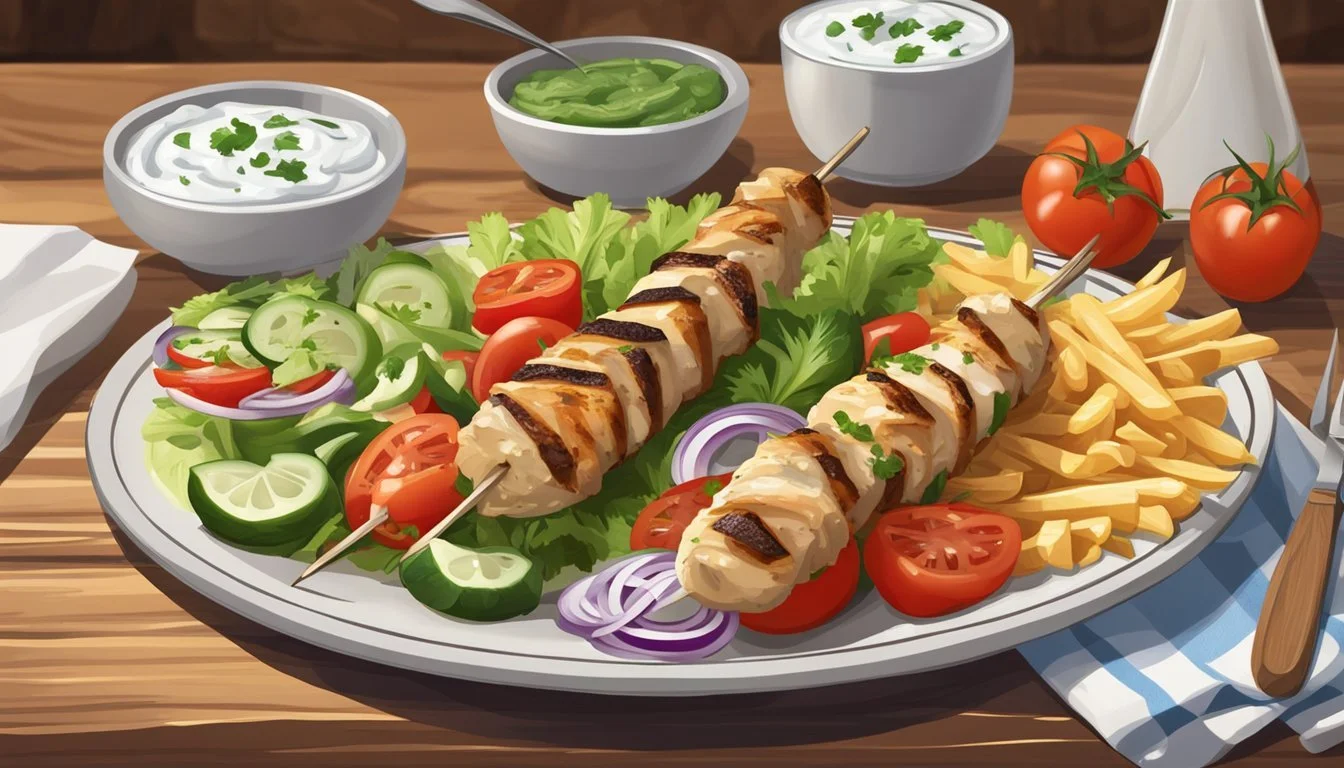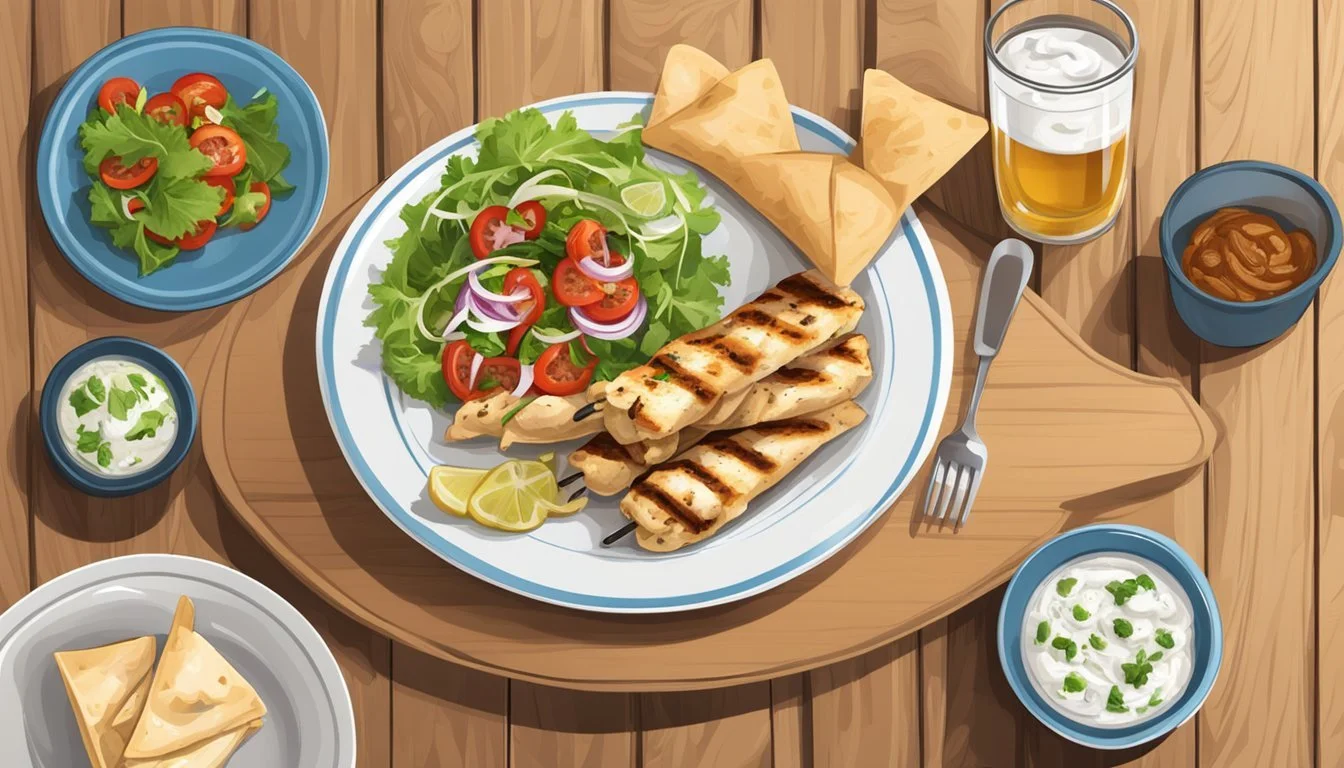How Long Does Chicken Souvlaki Last?
Shelf Life and Storage Tips
Greek chicken souvlaki, with its savory marinade and juicy grilled meat, is a beloved dish. Frequently featured at gatherings and barbecues, it represents Greek cuisine's vibrant flavors. It is often accompanied by tzatziki, a refreshing yogurt-based sauce, and pita bread, creating a complete and satisfying meal.
Chicken souvlaki can last up to three to four days in the refrigerator if stored properly in an airtight container. This time frame ensures the meat's taste and texture are preserved, providing safety for consumption. Reheating souvlaki while maintaining its tenderness is crucial, as leftover chicken can become dry or lose its flavorful essence.
Knowing the shelf life of chicken souvlaki not only helps in meal planning but also ensures that you can enjoy this delicious dish with confidence, whether freshly made or as leftovers. Proper storage and reheating methods are key to preserving its delightful taste and aroma, making every bite enjoyable.
Understanding Chicken Souvlaki
Chicken souvlaki is a beloved Greek dish known for its succulent grilled meat, aromatic spices, and versatility. This section explores its origins, key ingredients, variations, and nutritional value.
Origins of Chicken Souvlaki
Chicken souvlaki has deep roots in Greek cuisine. Traditionally served as street food, it showcases the simplicity and flavor focus of Mediterranean cooking. Souvlaki dates back to ancient Greece, where meat (often lamb or pork) was skewered and cooked over an open flame. The word "souvlaki" itself comes from the Greek word "souvla," meaning skewer.
Today, chicken souvlaki has become popular worldwide, maintaining its position as a quintessential Greek street food.
Key Ingredients and Variations
Essential ingredients in chicken souvlaki include chicken breast or thigh pieces marinated in a blend of lemon juice, olive oil, garlic, oregano, and other spices like paprika and rosemary. The marinade imparts a zesty, herbaceous flavor.
Grilled meat skewers are typically served with pita bread, fresh vegetables, and tzatziki sauce.
Variations of the dish can include different proteins, such as pork or lamb, or adaptations like vegetarian souvlaki made with tofu or mushrooms.
Nutritional Value of Chicken Souvlaki
Chicken souvlaki is a nutrient-dense dish, providing high-quality protein and essential vitamins. A typical serving includes skewered grilled chicken, offering a lean source of protein, vital for muscle maintenance and overall health.
The marinade, rich in extra virgin olive oil, provides healthy fats, while ingredients like garlic and oregano offer antioxidants.
Pairing souvlaki with sides such as fresh vegetables and whole grain pita can enhance its nutritional profile, making it a balanced meal option within Mediterranean diets.
Combining flavorful and healthy ingredients, chicken souvlaki is not only delicious but also a nutritious choice.
Preparing Chicken Souvlaki
For the perfect chicken souvlaki, several key steps are essential, from selecting quality chicken to marinating and skewering. Using high-quality ingredients ensures the best flavor and texture.
Selecting Quality Chicken
Choosing the right chicken is crucial. Opt for boneless, skinless chicken breasts or thighs. Freshness is paramount, as it affects the texture and taste. High-quality chicken should be firm to the touch and free from any strong odors.
Organic or free-range chicken can offer better texture and flavor. When shopping, look for chicken with a consistent color, free from dark spots or blemishes.
Creating the Souvlaki Marinade
A flavorful marinade forms the base of tasty souvlaki. The marinade typically includes olive oil, fresh lemon juice, garlic, oregano, salt, and black pepper. A hint of paprika or rosemary can add extra depth.
Combine these ingredients to create a balance of acidity and spice. The olive oil helps in coating the chicken evenly, while lemon juice tenderizes the meat. Remember to mix the ingredients thoroughly for a consistent flavor.
Marinating the Chicken
Proper marination is essential. Cut the chicken into bite-sized cubes before placing it in a large ziplock bag or bowl. Ensure the marinade fully covers the chicken pieces.
For best results, marinate the chicken for at least two hours. Allowing it to marinate overnight intensifies the flavors and ensures the chicken remains tender when cooked. If time permits, refrigerate the marinated chicken to infuse it with more flavor.
Skewering Techniques for Chicken Souvlaki
Before skewering, soak wooden skewers in water for 15 minutes to prevent burning. Thread the marinated chicken pieces onto the skewers loosely to allow even cooking.
Ensure each piece has enough space to cook on all sides. Preheat your grill to high heat, and cook the chicken skewers for 8 to 10 minutes, turning them occasionally. The chicken should be golden and cooked through, with an internal temperature reaching 165°F (75°C).
By following these steps, you ensure the chicken souvlaki is flavorful, tender, and perfectly cooked.
Cooking Methods for Chicken Souvlaki
Chicken souvlaki can be prepared using various cooking methods. Grilling, oven cooking, and alternative techniques each offer unique benefits to achieve the perfect flavor, juiciness, and texture of the meat.
Grilling Chicken Souvlaki
Grilling is one of the most traditional methods to cook chicken souvlaki. To start, preheat a grill to medium-high heat. Skewer marinated chicken pieces, ensuring they're evenly spaced to cook thoroughly. Place them on the grill grates, turning occasionally to achieve even grill marks.
The internal temperature should reach 165°F (74°C), so it's crucial to use a meat thermometer. Typically, it takes about 8-10 minutes for the chicken to cook through. Once done, remove from the grill and let the skewers rest for a few minutes. This allows the juices to redistribute, resulting in tender and flavorful meat.
Oven Cooking Options
Oven cooking is a convenient alternative to grilling, especially for those without access to a grill. Preheat the oven to 350°F (175°C). Place the marinated chicken skewers in an oven-safe dish. Adding a small amount of chicken broth or water helps keep the meat moist. Cover the dish with foil to trap steam.
Bake for 15-20 minutes, then remove the foil and bake for an additional 5 minutes for a slight crisp. To ensure the chicken is cooked, check that the internal temperature is 165°F (74°C) with a meat thermometer. Rest the chicken before serving to enhance its flavor and texture.
Alternative Cooking Techniques
While grilling and oven cooking are common, other methods can also deliver delicious results. A grill pan or frying pan heated over medium-high heat can mimic the grill's effect. Brush the pan with olive oil and cook each side for about 1 minute until grill marks appear.
For added convenience, an air fryer can be used. Preheat the air fryer to 360°F (182°C), cook the chicken skewers for about 10-12 minutes, shaking the basket halfway through. Lastly, the broiler can be a quick method: place skewers under the broiler on high for about 5-7 minutes per side, ensuring they don’t burn.
These alternative techniques offer flexibility while still achieving the desired internal temperature of 165°F (74°C). Always use a meat thermometer for accuracy.
Serving Suggestions for Chicken Souvlaki
Chicken Souvlaki pairs beautifully with a variety of Mediterranean complements. Consider flavorful sides and thoughtful presentation to enhance the meal experience.
Accompaniments and Side Dishes
For a complete Mediterranean meal, serve chicken souvlaki with Greek pita bread and a homemade tzatziki sauce. This tangy, creamy dip made from Greek yogurt, cucumbers, garlic, and dill enhances the grilled chicken's flavors.
Include a traditional Greek salad, featuring tomatoes, cucumbers, red onions, Kalamata olives, and feta cheese. Drizzle with extra virgin olive oil and lemon juice for a refreshing complement.
Orzo salad is another excellent side, with ingredients like spinach, cherry tomatoes, and fresh herbs. Fries or roasted potatoes flavored with oregano and lemon are delightful options as well.
Presentation Ideas
Present chicken souvlaki on skewers for an authentic touch. Accompany the skewers with warm pita on the side for easy dipping and assembling.
Arrange tzatziki sauce in small bowls for guests to serve themselves. Place the souvlaki skewers, pita bread, and sides on a large platter for a communal dining experience.
Garnish with fresh herbs like parsley or dill for a vibrant finish. Add lemon wedges for an extra splash of color and a convenient way to add fresh citrus flavor.
To elevate the presentation, use colorful serving bowls and platters that complement the Mediterranean theme. The thoughtful arrangement of components makes the meal visually appealing and inviting.
Storing Chicken Souvlaki
Chicken souvlaki can be preserved well if stored properly, ensuring it remains safe and flavorful for future meals. It involves proper refrigeration, freezing, and careful reheating techniques.
Proper Refrigeration
After cooking, chicken souvlaki should be refrigerated within two hours to maintain safety and quality. Leftovers should be placed in an airtight container to prevent contamination and moisture loss.
To maximize freshness, it is recommended to refrigerate chicken souvlaki at temperatures below 40°F (4°C). The chicken can last in the refrigerator for up to three days. Avoid storing it at room temperature for more than a couple of hours.
Freezing and Thawing
For longer storage, chicken souvlaki can be frozen. Wrap the skewers tightly in foil and place them in airtight containers or freezer bags. Label with dates to keep track of freezing time.
Proper freezing can extend the shelf life up to three months. When ready to use, thaw the chicken in the refrigerator overnight. Never thaw at room temperature as it can promote bacterial growth.
Reheating Stored Chicken Souvlaki
Reheating chicken souvlaki requires care to maintain tenderness and flavor. Microwave, oven, or stovetop methods are effective. If using the microwave, cover with a damp paper towel to avoid drying out.
For oven reheating, preheat to 350°F (175°C) and heat the chicken covered with foil for 10-15 minutes. On the stovetop, heat on medium, turning occasionally until evenly warmed. Always ensure that the internal temperature reaches at least 165°F (74°C) before consumption.
Safety and Quality Considerations
When storing chicken souvlaki, it's crucial to ensure it remains fresh and safe to eat. Monitoring freshness and adhering to proper food safety practices are key.
Determining Freshness and Spoilage
For optimal quality, chicken souvlaki should be stored in the refrigerator and consumed within 3-4 days. Using a meat thermometer to check for an internal temperature of 165°F (74°C) can ensure the chicken is cooked properly.
Signs of spoilage include off-putting odors, a slimy texture, and discoloration. If any of these signs are present, discard the chicken to avoid foodborne illness. Pay attention to any unusual smells or changes in the meat’s appearance, as these are reliable indicators of spoilage.
Best Practices for Food Safety
Store chicken souvlaki in airtight containers to maintain its flavor and prevent contamination. Ensure the refrigerator is set to 40°F (4°C) or lower.
When reheating, it’s advisable to use the oven at 350°F or the stovetop. Always use a meat thermometer to check that the internal temperature has reached 165°F (74°C). Avoid leaving cooked chicken at room temperature for more than two hours to inhibit bacterial growth. These practices help in maintaining the versatile use and quality of the chicken souvlaki.






